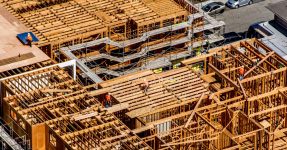
Please Recycle This Building When Not in Use
In July 2028, Los Angeles will host the Summer Olympic Games. There might be years of prep earlier than then: architectural plans, new development, and infrastructure to accommodate the tens of hundreds of arriving athletes, to not point out the thousands and thousands of spectators trickling in from world wide.
But when the Olympics are over and everybody goes dwelling, these new buildings—sports activities venues, athlete dorms, restrooms, memento retailers, eating places, and concession stands—will sit empty. Looming over the Olympics’ afterlife is the substantial and considerably difficult query of what the occasion’s planning crew will do with them.
“Those buildings don’t get used after the four weeks of the Olympics and Paraolympics,” says California-based architect Rob Berry. “They become obsolete. We are thinking about how buildings are made and really looking at it.”
Berry is an assistant professor on the University of Southern California School of Architecture and principal at Los Angeles-based agency Berry and Linné. He says the setup presents an unbelievable alternative to discover some very huge questions in regards to the stream of development waste generated yearly. To make that time, the scholars in his second-year undergraduate studio are onerous at work on a undertaking he’s calling Making LA. It focuses on designing buildings for the LA 2028 Olympics that may rework, disappear, or start a second life after the spectacle is over.
Just a few of the concepts the USC college students have dreamed up embody a concession stand that may be disassembled and recycled or reused after the video games for a special objective and a media heart that may be remodeled right into a public library. The undertaking is a component concept, half design train, as Berry hasn’t been in contact with the LA28 planning committee … but.
“I have discussed the studio with USC’s Office of Sustainability, and next spring we will likely involve members of the USC community that are involved in preparing USC’s facilities for the Olympics,” he says. “It’s more of an academic exercise the first go-around, but larger engagement will be emphasized more as I refine the brief.” Still, Making LA could be very a lot rooted in actuality: answering some perplexing and urgent questions on the way forward for structure, development, and constructing design. “How would a building work on day one?” asks Berry. “And what also happens in five years and 10 years when it’s outdated and its intended use has changed, not just becoming waste?”
Exploring Circularity
Globally, the development trade creates about one-third of the world’s waste. The Environmental Protection Agency estimated in 2018 that 600 million tons of development and demolition waste is generated yearly in the US alone. The associated implications of those two stats are usually not solely materials (trash headed for landfills), but additionally environmental (carbon emissions, air high quality, noise air pollution). And as architects, contractors, designers, and coverage makers unpack the difficulty, Making LA is a part of a burgeoning give attention to what’s known as round constructing—the apply of creating buildings that may be extra simply disassembled, moved, or repurposed. It additionally locations a powerful emphasis on supplies that could be reused as a substitute of ending up in a landfill.
Just a few latest examples of the method in motion embody a waterfront Copenhagen bar and restaurant constructed for eventual relocation; Philadelphia structure agency Kieran Timberlake’s progressive prefab, sustainable properties Loblolly House and Cellophane House; a 3D-printed dwelling made fully from forest supplies on the University of Maine; and a timber body workplace constructing in Oslo. Startups are fueling a shift towards round constructing too: Rheaply is a Chicago-based useful resource trade platform constructed to assist firms and organizations reuse supplies to allow them to attain sustainability objectives, whereas Rotor Deconstruction is a Brussels-based co-op that dismantles, organizes, and trades salvaged components of buildings.
While round development and design for disassembly is usually practiced on a smaller scale, many architects and designers are pushing the concept ahead and testing the bounds of what’s doable with bigger tasks.






